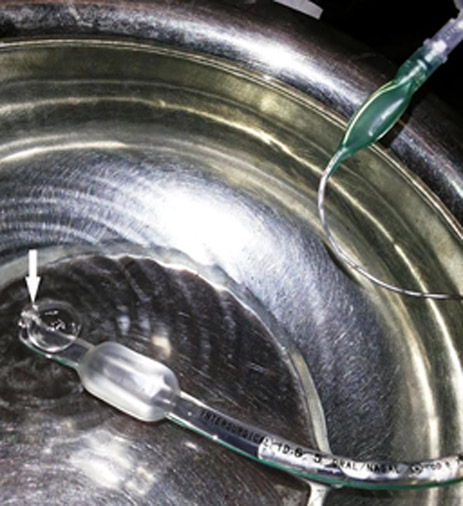*Professor; **Assistant Professor, ***Post Graduate Trainee
Department of Anesthesia and Intensive Care, Govt. Medical College and Hospital, Chandigarh (India)
Correspondence: Dr. Dheeraj Kapoor, 207, Sector 32 B, Chandigarh, India-160030; Phone: 911724622549, 919646121549; E-mail: kapoor.dheeraj72@gmail.com
Key words: Intubation: Pneumoperitoneum
Citation: Lakesh AK, Kapoor D, Singh A. Endotracheal tube cuff leak: yet another unusual cause! Anaesth Pain & Intensive Care 2014;18(3):317-18
Despite routine practice of pre-use visual inspection and testing of ETT for physical defects, some manufacturing defects still go unnoticed and may lead to partial or complete failure of ventilation in intubated patient.1-4 A 36-year-old female, ASA physical status I, weighing 45 kg, was scheduled for elective laparoscopic cystectomy for ovarian cyst. Standard GA and monitoring techniques were employed. After routine pre-use check for any visible physical defects, a 7.5 mm internal diameter cuffed ETT (InTube® Intersurgical Ltd., UK) was selected for orotracheal intubation. Correct ETT position was confirmed by end-tidal carbon dioxide (EtCO2) trace. A close circle system was used and ventilator adjusted to achieve effective oxygenation (SpO2 ≥ 95%) and ventilation (EtCO2 35-40 mmHg) with volume-controlled mode. Pneumoperitoneum with carbon dioxide was created and intra-abdominal pressure was held at 12 mmHg. Patient was then placed in Trendelenberg’s and lithotomy position. Within few minutes after the commencement of surgery, we noticed the collapsing ventilator bellows and air leak from the mouth as evident by a bubbling sound. Surgery was stopped and pneumoperitoneum released. Patient was placed in supine position and ETT position was confirmed by chest auscultation and ETT marking at the level of the lips. The pilot balloon was found partially deflated and was re-inflated with air. However, after few minutes, air leakage with a deflated pilot balloon was noticed again. Suspecting a possible damage of the ETT cuff or inflation assembly, the ETT was immediately replaced by a fresh ETT of same size. Subsequently no further problems were observed and the surgery was completed uneventfully.
We checked the removed ETT by inspecting and inflating the cuff but could not find any visible defect in the cuff or in the inflation assembly including pilot balloon. Then the tube was immersed in water to identify the exact point of air leakage. We observed a continuous air leakage, visible as bubbles, from the distal most end of the inflation channel (Figure 1).
Figure 1: Arrow showing air leakage from distal end of ETTAir leakage around the cuff may be seen due to inadequate cuff inflation or use of a smaller tube. It may be seen in clinical situations such as cephalad migration of ETT,2 tracheal misplacement of nasogastric tube,5 or high peak airway pressures.6 Rarely, air leakage may be seen due to structural defects in the cuff and/or cuff inflation assembly.1-4 The resultant inadequate tidal volume may necessitating immediate ETT replacement.2 In our case, an increased intra-abdominal pressure secondary to pneumoperitoneum coupled with Trendelenburg plus lithotomy positions may have increased the peak airway pressure and subsequent intracuff pressure leading to cuff leakage from the defective inflation channel.
It was noticed that even after proper pre-use check, some untoward manufacturing defects may still go unnoticed leading to unwanted consequences.
REFERENCES- Gettelman TA, Morris GN. Endotracheal tube failure: undetected by routine testing. Anesth Analg 1995;81:1313. [PubMed]
- Kearl RA, Hooper RG. Massive airway leaks: an analysis of the role of endotracheal tubes. Crit Care Med 1993;21:518-21. [PubMed]
- Heusner JE, Viscomi CM. Endotracheal tube cuff failure due to valve damage. Anesth Analg1991;72:270. [PubMed]
- Malhotra N, Singhal S. Slow deflation of a tracheal tube cuff: an unusual cause. Acta Anaesthesiol Scand 2006;50:519-20. [PubMed]
- El-Orbany M. Detection of inadvertent tracheal placement of nasogastric tubes. Acta Anaesthesiol Scand 2008;52:574-5. [PubMed]
- Efrati S, Deutsch I, Gurman GM. Endotracheal tube cuff small important part of a big issue. J Clin Monit Comput 2012;26:53-60. [PubMed]
